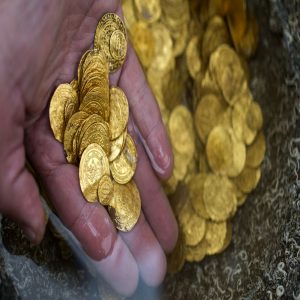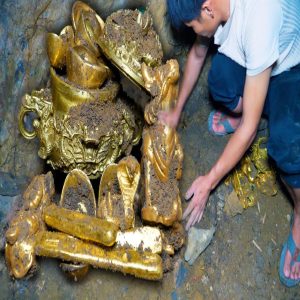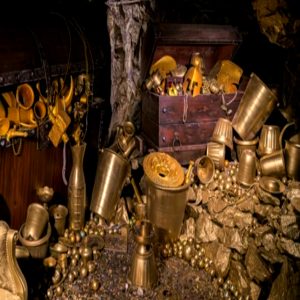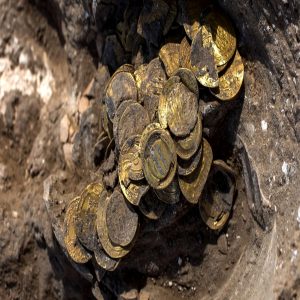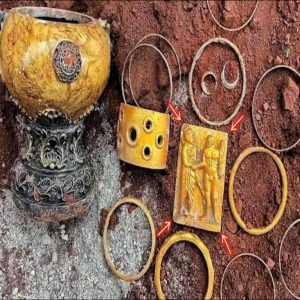The quiet expanse of the Borki Forest in Masuria, northern Poland, recently revealed a hidden treasure trove of Roman-era artifacts. Thanks to the dedicated efforts of local history enthusiasts from the Wendrusz Historical and Exploration Society, a remarkable discovery was made during an exploratory field search. What began as a casual hunt for World War II relics turned into a significant archaeological find that offers new insights into Poland’s ancient past.
Discovering History in the Forest
The discovery took place in the Borki forest district, a region already steeped in natural beauty and historical significance. Members of the Wendrusz Society, Bartosz Łaszczuk and Tomasz Trypuć, stumbled upon the artifacts while conducting a routine field survey. With the permission of local heritage protection authorities and the landowner, the team uncovered four fibulae (brooches), a bronze ring, and other decorative fragments. These artifacts, dating to the late 2nd and early 3rd century CE, reflect a period marked by Roman cultural and economic influence.
Initial observations suggest that the site may have been part of a Bogaczewo or Sudovian culture cemetery or settlement. These cultures, known for their distinct funerary practices and material artifacts, thrived during an era when Roman trade routes extended into Central Europe. The discovery was shared on social media by the Wendrusz Society, igniting local and academic interest in the find.
Artifacts of Cultural Significance
The unearthed artifacts provide valuable clues about the lives and interactions of the people who inhabited this region nearly 2,000 years ago. Fibulae, often used as brooches or fasteners for garments, are particularly significant as they represent both functional items and symbols of status and identity. The design and craftsmanship of these fibulae suggest connections to Roman trade and cultural exchanges.
The bronze ring and other decorative items further highlight the sophistication of the material culture in this region. Each item was meticulously documented with GPS coordinates and marked on a digital map, a process that ensures their proper contextualization for future archaeological analysis. According to Anna Dymkowska-Kowalska, a member of the Wendrusz Society, these efforts are crucial for preserving the integrity of the site and aiding future studies.


The artifacts unearthed shed light on the lives and interactions of the people who lived in this region nearly 2,000 years ago.
Roman Influence and Local Context
The artifacts’ Roman-era origins shed light on the far-reaching influence of the Roman Empire, even in regions far removed from its borders. The late 2nd to early 3rd century CE was a period of extensive trade and cultural interaction, facilitated by established trade networks that connected the Roman world with Central and Eastern Europe. Items such as the fibulae likely reached this region through these networks, demonstrating how Roman goods and ideas permeated local cultures.
Local history enthusiasts have speculated that the discovery may point to the existence of a cemetery or settlement belonging to the Bogaczewo or Sudovian cultures. These groups, known for their distinctive burial customs, often included decorative items and personal belongings in graves, making the Borki forest site a promising area for further investigation.

A beautifully crafted bronze ring and other decorative items reveal the remarkable sophistication of the material culture in this area.
The Role of Wendrusz Historical Society
The Wendrusz Historical and Exploration Society, established in 2021, has become a vital part of local historical preservation efforts. Operating from a small history chamber in the former Węgorzewo railway station, the society has been instrumental in uncovering and documenting numerous artifacts. Their latest find in the Borki forest is one of several significant contributions to understanding the region’s rich history.
In addition to the recent Roman-era discovery, Wendrusz has reported finds such as a socketed axe and a dagger blade, both unearthed during agricultural work. The society has also preserved historical documents dating back to the 18th century, showcasing its dedication to protecting cultural heritage across various time periods.


The intricate design and craftsmanship of the fibulae point to thriving Roman trade networks and cultural exchanges during the era.
Archaeological Assessment and Future Plans
Following the discovery, the artifacts were reported to the Provincial Office for the Protection of Monuments in Ełk and the State Forests. Magdalena Kozicka, an archaeology specialist, confirmed that the site would be assessed for inclusion in the monument registry. This step is critical for ensuring the site’s long-term preservation and protecting it from potential damage during future activities in the area.
The artifacts will be transferred to a regional museum, where they will undergo further analysis by experts. These studies aim to uncover more details about the objects’ origins, functions, and cultural significance. Additionally, plans are underway to include the artifacts in public exhibits, allowing the local community and visitors to appreciate their historical value.
Connecting the Past and Present
The discovery of Roman-era artifacts in the Borki forest serves as a powerful reminder of the connections between past and present. It highlights the enduring legacy of Roman cultural and economic influence, as well as the role of local communities in preserving history. The meticulous efforts of the Wendrusz Society demonstrate how grassroots initiatives can contribute to broader archaeological and historical knowledge.
Moreover, the find underscores the importance of responsible artifact collection and documentation. By working closely with heritage authorities and adhering to best practices, the Wendrusz Society has set a strong example for other amateur historians and enthusiasts.
Conclusion
The Roman-era artifacts unearthed in the Borki forest are more than just objects of historical interest—they are tangible links to a complex past that continues to shape our understanding of cultural interactions and human ingenuity. Thanks to the dedication of the Wendrusz Historical and Exploration Society, these treasures have been brought to light, enriching our knowledge of Poland’s ancient heritage. As further studies and excavations unfold, the site promises to reveal even more about the lives and legacies of those who lived in this region nearly two millennia ago.

